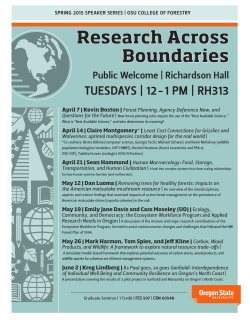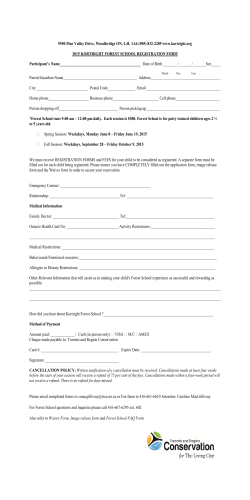
Forests in Lebanon
Implementation of the National Afforestation/Reforestation Programme (NARP) Lebanon Mitigation Action Dr. Chadi Mohanna Ministry of Agriculture RDNRD Forests in Lebanon •Total area : 10.452 Km2 •Forests: 13% of total area •Other Wooded Land - OWL: 11% •Major spp.: Quercus sp. (41.6%), Pinus sp. (20.3%), Cedrus libani (1.6%) Forest ownership : - 1/3 of private and religious properties - 1/3 of communal lands (municipalities) - 1/3 of state lands Threats and Challenges • Urban expansion, quarries and road construction. • Forest fires. • Illegal tree felling. • Encroachment on forest lands by agriculture. • Unorganized grazing inside forests. • Insects and diseases. • Shortage of funds needed to support reforestation • Difficulty of natural regeneration particularly in dry areas (climate change) • The conflict in Syria which resulted in the flux of over one and a half million refugees to Lebanon. • Increased pressure on Natural Resources The mitigation action MoA in Lebanon has developed a NAMA : • Implementation of the National Afforestation/Reforestation Programme (NARP) • Restoring and developing forest land and tree cover • Increase forests from 13% of Lebanon’s total area to 20% • Period of 20 years starting 2015. Five main components: 1. Identifying suitable areas for reforestation 2. Reforestation process 3. Developing and implementing a Measurement, Reporting and Verification (MRV) procedure. 4. Institutional adaptation and Capacity building. 5. Stakeholders consultation and local communities participation. 1- Identifying suitable areas for reforestation (on going) • • • • • • • • Base map under construction (ARDP) State and communal lands Characterization of areas Suitable techniques Suitable species Mapping of reforestation units + scenarios Field verifications (MoA) Decision making and management tool for reforestation Villages borders Reforestation sites in a village LULC of the village Altitude Soil type Reforestation site data Planting techniques Adapted/Associated species 2- Reforestation process • Gradually by phases • First phase to be launched for 16.000 ha over a period of 8 years • Next phases (on the basis of lessons learned) • Surface will be increased to reach the target of 70000 ha in 20 years. • Partnership approach (Universities, NGOs and Municipalities) 3- Developing and implementing MRV procedure • Forest carbon stocks/reforestation scenario – Types of vegetation – Density – Etc… • Local Inventory Report of GHG • Adopting the GPG of the LULUCF sector (IPCC) 4. Institutional adaptation and Capacity building • Enhancing skills of forest and natural resources practitioners • Public sector, NGOs, Universities, Municipalities, … • Specific capacity building for FA : – Complete site identification – Implement MRV procedures 5. Stakeholders consultation and local communities participation • Inter Ministerial Committee for the NARP • Private Public Partnership • Three widely active Ministries – MoA : Directorate of Rural Development and Natural Resources – MoE : UNCCC, UNCBD and Natural Reserves – MoIM : Municipalities and Civil Defense • Large network of active NGOs Sequestered Carbon - The estimated quantity of sequestered carbon will range between 8.07 tCO2/ha/year and 9.3 tCO2/ha/year. - The cumulative sequestered carbon for the 16.000 ha over a period of 8 years will therefore range between 581040 tCO2 and 669600 tCO2. - The cumulative sequestered carbon for the 70.000 ha could range between 11.4 million tCO2 and 13.6 million tCO2. Co-benefits Sustainable Development Ecological-environmental Economic Socio-political Co-benefits Protective functions: protection of watersheds including biodiversity, soil and water conservation. Protection from wind and water erosion, coastal protection, landslides and air pollution filters. Increase availability of wood and non-wood forest products: fuel-wood, food (fruits, edible plants, aromatic and medicinal plants), fodder, honey and many other NWFPs. Ecotourism. . Employment opportunities. Transfer of technology and know-how. Gender equity. Mitigation of poverty in the poverty prone areas in the country especially in light of the conflict in Syria. Inter-sectoral collaboration Collaborate towards consensual land use planning system. The private sector involvement Valuable added value. Incremental costs - Institutional adaptation. - Implementation of the MRV procedure: - delineation of project boundaries, - land use and land cover mapping, - capacity building - Identify potential lands - Acquisition of certain lands of special interest - Establishing hill lakes: irrigation, fire fighting Thank you for your attention
© Copyright 2026









